Discover 20 hidden attractions, cool sights, and unusual things to do in Sunderland (United Kingdom). Don't miss out on these must-see attractions: Mowbray Park, Stadium of Light, and Penshaw Monument. Also, be sure to include Hylton Castle in your itinerary.
Below, you can find the list of the most amazing places you should visit in Sunderland (England).
Table of Contents
Mowbray Park
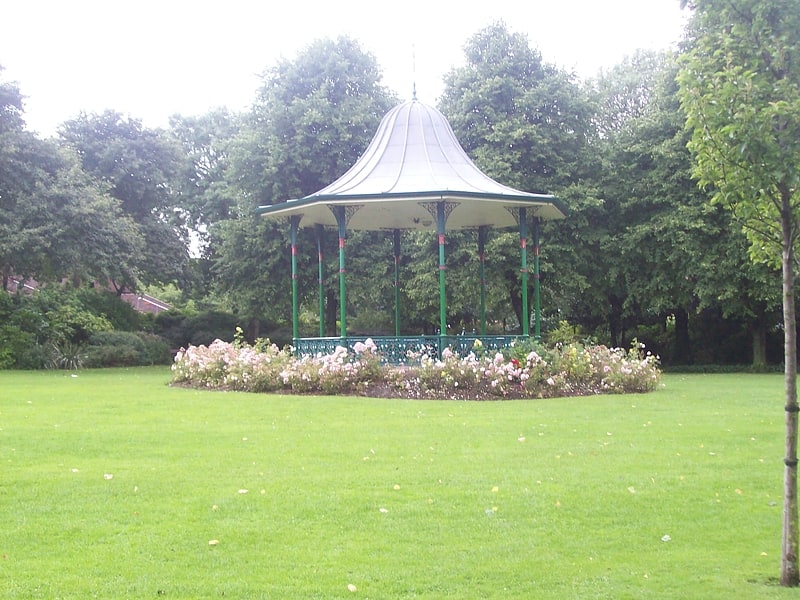
Park in Sunderland, England. Mowbray Park is a municipal park in the centre of Sunderland, Tyne and Wear, England, located a few hundred yards from the busy thoroughfares of Holmeside and Fawcett Street and bordered by Sunderland Museum and Winter Gardens to the north, Burdon Road to the west, Toward Road to the east and Park Road to the south. The park was voted best in Britain in 2008.[1]
Address: Burdon Rd., SR1 1QB Sunderland
Stadium of Light
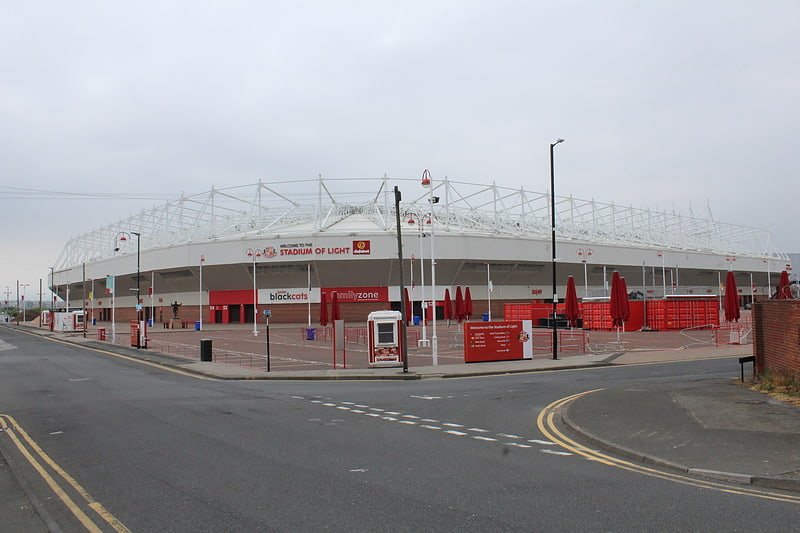
Stadium in Sunderland, England. The Stadium of Light is an all-seater football stadium in Sunderland, England, and the eighth and current home to Sunderland A.F.C. With space for 49,000 spectators, the Stadium of Light is the ninth largest stadium in England. The stadium primarily hosts Sunderland A.F.C. home matches. The stadium was named by chairman Bob Murray to reflect the coal mining heritage of the North East and the former Monkwearmouth Colliery site on which it stands. A Davy lamp monument stands at the entrance to reflect the coal mining industry that brought prosperity to the town.
As well as hosting Sunderland games, the stadium has hosted three matches for the England national football team, as well as an England under-20, an England under-21 and an England women's team match. With an original capacity of 42,000, it was expanded in 2000 to seat 49,000. Its simple design is apparently to allow for redevelopments up to a capacity of 63,000. The attendance record at the Stadium of Light is 48,353 set on 13 April 2002, when Sunderland played Liverpool with the visitors running out 1–0 winners. Along with hosting football matches, the stadium has played host to performers such as Beyoncé, Rihanna, Oasis, Take That, Kings of Leon, Coldplay, Spice Girls and Elton John. The ground also holds conference and banqueting suites, the Black Cats Bar, and a club shop selling Sunderland merchandise.[2]
Address: Millennium Way, SR5 1SU Sunderland
Penshaw Monument
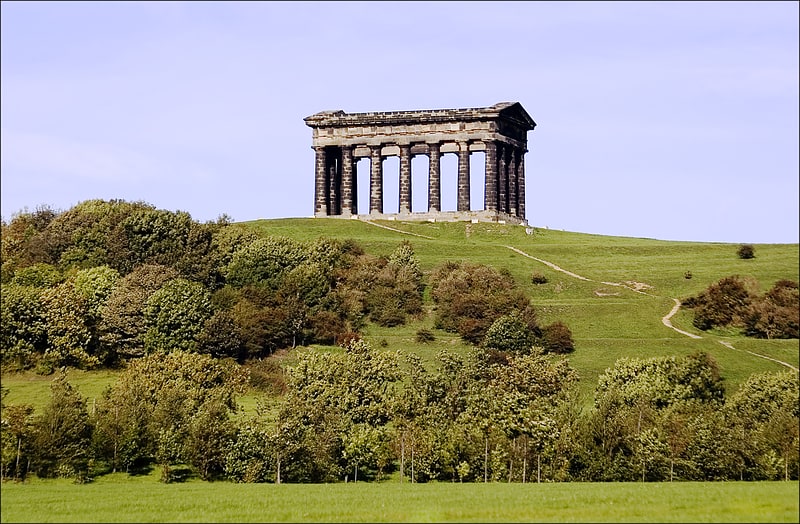
The Penshaw Monument is a memorial in the style of an ancient Greek temple on Penshaw Hill in the metropolitan borough of the City of Sunderland, North East England. It is located near the village of Penshaw, between the towns of Washington and Houghton-le-Spring in historic County Durham. The monument was built between 1844 and 1845 to commemorate John Lambton, 1st Earl of Durham, Governor-General of British North America and author of the Durham Report on the future governance of the American territories. Owned by the National Trust since 1939, it is a Grade I listed structure.
The monument was designed by John and Benjamin Green and built by Thomas Pratt of Bishopwearmouth using local gritstone at a cost of around £6000; the money was raised by subscription. On 28 August 1844, while it was partially complete, its foundation stone was laid by Thomas Dundas, 2nd Earl of Zetland in a Masonic ceremony which drew tens of thousands of spectators. Based on the Temple of Hephaestus in Athens, it is a tetrastyle temple of the Doric order, with eighteen columns—seven along its longer sides and four along its shorter ones—and no roof or cella (inner chamber).
One column contains a spiral staircase leading to a parapeted walkway along the entablature. This staircase was closed to the public in 1926 after a 15-year-old boy fell to his death from the top of the monument. The structure fell into disrepair in the 1930s and was fenced off, then repaired in 1939. It has since undergone further restoration, including extensive work in 1979 during which its western side was dismantled. Floodlit at night since 1988, it is often illuminated in different colours to mark special occasions. The National Trust began to offer supervised tours of the walkway in 2011.
Penshaw Monument is a local landmark, visible from up to 80 kilometres (50 mi) away. It appears on the crest of Sunderland A.F.C. and is viewed nationally as a symbol of the North East. It has been praised for the grandeur, simplicity and symbolic significance of its design, especially when seen from a distance. However, critics have said it is poorly constructed and lacks purpose; nineteenth-century architectural journals condemned its lack of a roof and the hollowness of its columns and walls. It features no depiction of the man it honours, and has been widely described as a folly.[3]
Address: A 183 Chester Road, DH4 7EL Houghton-le-Spring
Hylton Castle
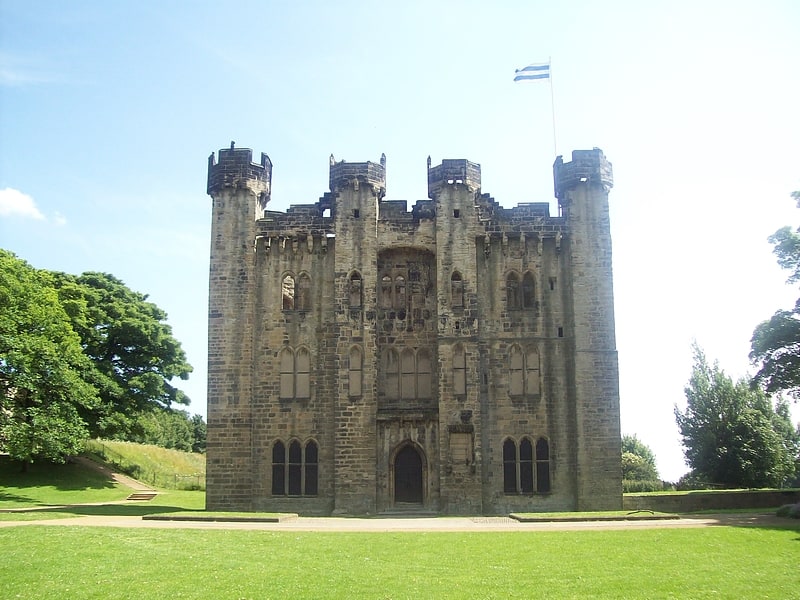
Castle in Sunderland, England. Hylton Castle is a stone castle in the North Hylton area of Sunderland, Tyne and Wear, England. Originally built from wood by the Hilton family shortly after the Norman Conquest in 1066, it was later rebuilt in stone in the late 14th to early 15th century. The castle underwent major changes to its interior and exterior in the 18th century and it remained the principal seat of the Hylton family until the death of the last Baron in 1746. It was then Gothicised but neglected until 1812, when it was revitalised by a new owner. Standing empty again until the 1840s, it was briefly used as a school until it was purchased again in 1862. The site passed to a local coal company in the early 20th century and was taken over by the state in 1950.
One of the castle's main features is the range of heraldic devices found mainly on the west façade, which have been retained from the castle's original construction. They depict the coats of arms belonging to local gentry and peers of the late 14th to early 15th centuries and provide an approximate date of the castle's reconstruction from wood to stone.
Today, the castle is owned by English Heritage, a charity which manages the historical environment of England. The surrounding parkland is maintained by a community organisation. The castle and its chapel are protected as a Grade I listed building and a Scheduled Ancient Monument. In February, 2016, plans were announced to turn the castle into a community facility and visitor attraction, with the Heritage Lottery Fund awarding £2.9 million, and Sunderland Council £1.5 million, to provide classrooms, a cafe and rooms for exhibitions, meetings and events.[4]
Address: Washington Rd., SR5 3PP Sunderland
Sunderland Museum and Winter Gardens

Museum in Sunderland, England. Sunderland Museum and Winter Gardens is a municipal museum in Sunderland, England. It contains the only known British example of a gliding reptile, the oldest known vertebrate capable of gliding flight. The exhibit was discovered in Eppleton quarry. The museum has a Designated Collection of national importance.
It was established in 1846, in the Athenaeum Building on Fawcett Street, the first municipally funded museum in the country outside London. The first recorded fine art acquisition was commissioned by the Sunderland Corporation, a painting of the opening of the new South Dock in 1850. This may have been the first time that an artwork was commissioned by a town council.
In 1879, the Museum moved to a new larger building next to Mowbray Park including a library and winter garden based on the model of the Crystal Palace. U.S. President Ulysses Grant was in attendance at the laying of the foundation stone by Alderman Samuel Storey in 1877. The building opened in 1879.
During World War II, Winter Garden was damaged by a parachute mine in 1941 and demolished the following year. A 1960s extension took its place, but in 2001, a lottery funded refurbishment of the museum created a new Winter Garden extension and improved facilities.
The Winter Gardens contain over 2,000 flowers and plants.
In 2003, the Museum was recognised as the most attended outside London.
The Museum contains a large collection of the locally made Sunderland Lustreware pottery. Other highlights of the Museum are a stuffed Lion which was acquired in 1879, the remains of a walrus brought back from Siberia in the 1880s and the first Nissan car to be made in Sunderland. Also featured are the skeletal remains of a male human being and a dinosaur bone which was found in the local area.
The library moved in 1995 to the new City Library and Arts Centre on Fawcett Street (occupying part of the former Binns Department Store). The relocation left more space for museum exhibitions. The new City Library Arts Centre also houses the Northern Gallery for Contemporary Art, renowned as one of the leading forums for emerging artists in the North of England.
John Morrison wrote an affectionate memoir of the two and a half years he spent working in the museum as a junior curator, starting about 1918, which appeared in the Australian literary journal Overland in 1968.
L.S. Lowry described his discovery of Sunderland in 1960, after which it became his second home: "One day I was travelling south from Tyneside and I realised this was what I had always been looking for."
Sunderland Museum, with six works and 30 on long-term loan, have a Lowry collection surpassed only by Salford and Manchester.[5]
Address: Burdon Rd, SR1 1PP Sunderland
Washington Old Hall

Building in Washington, England. Washington Old Hall is a historic manor house in Washington, Tyne and Wear, England, United Kingdom. It lies in the centre of Washington, being surrounded by other villages. The building was the ancestral home of the family of George Washington, the first president of the United States.[6]
Address: Washington Old Hall Lodge The Avenue, NE38 7LE Washington
Sunderland Civic Centre
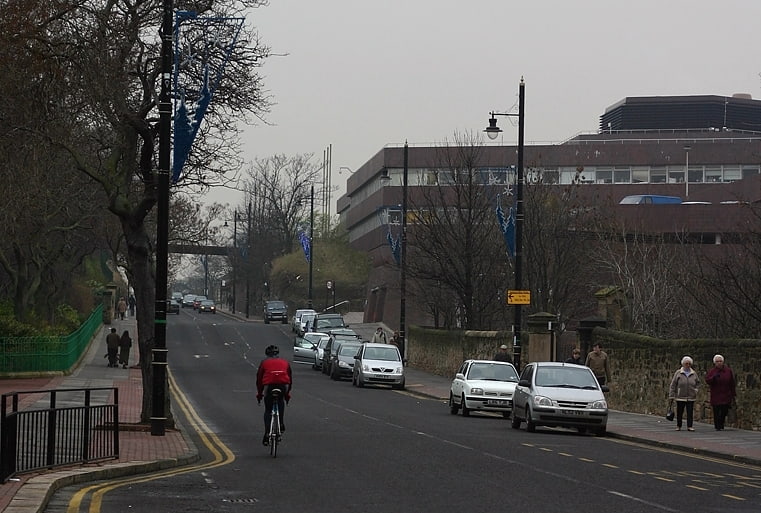
Sunderland Civic Centre was a municipal building in the Burdon Road in Sunderland, Tyne and Wear, England. It was the headquarters of Sunderland City Council until 31 November 2021.[7]
North East Land
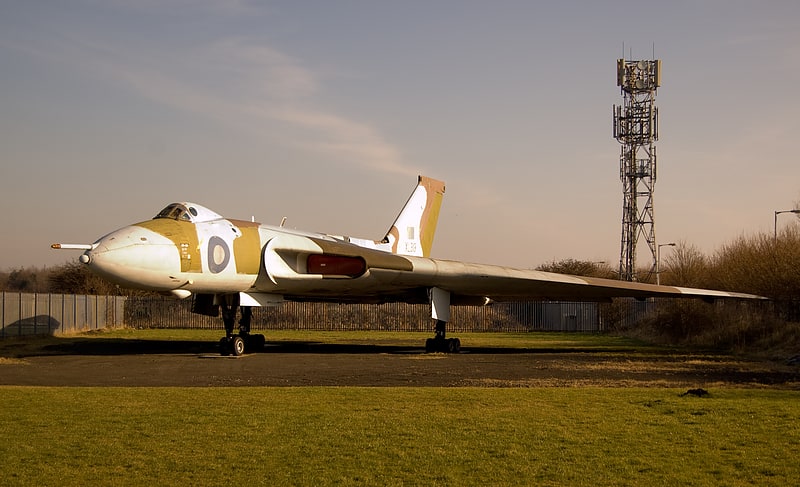
Museum in England. The North East Land, Sea and Air Museums, formerly the North East Aircraft Museum, is a volunteer-run aviation museum situated on the site of the former RAF Usworth/Sunderland Airport, between Washington and Sunderland, in Tyne and Wear, England. The museum has the largest aviation collection between Yorkshire and Scotland and houses over 30 aircraft and a wide collection of aero engines. The museum also has a small collection of other items such as weaponry, vehicles and other historical exhibits.
The museum also has special displays showing a replica of a Second World War British street and one honouring No. 607 Squadron RAF, which was based at RAF Usworth.
NELSAM is an English registered charity.[8]
Address: Washington Rd, SR5 3HZ Sunderland
Queen Alexandra Bridge
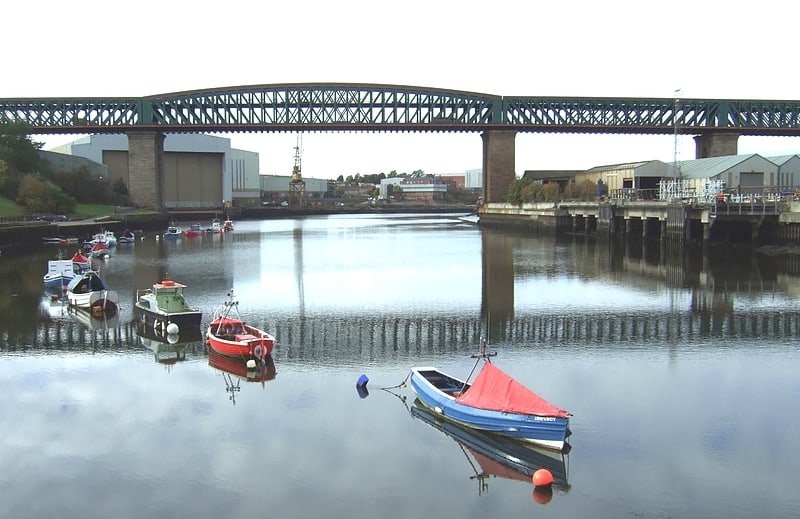
Truss bridge in Sunderland, United Kingdom. The Queen Alexandra Bridge is a road traffic, pedestrian and former railway bridge spanning the River Wear in North East England, linking the Deptford and Southwick areas of Sunderland. The steel truss bridge was designed by Charles A. Harrison. It was built by Sir William Arrol between 1907 and 1909 and officially opened by The Earl of Durham, on behalf of Queen Alexandra on 10 June 1909.
In 1899 the North Eastern Railway and the Sunderland Corporation agreed to build the bridge to improve communications across the river and to connect the coalfields of Annfield Plain and Washington with Sunderland's south docks. Before the completion of the bridge, road traffic crossing the river had to use one of two ferries which crossed below near to where the bridge is today. As the bridge was due to be built near to the successful shipyards of the Wear, a clause in the North Eastern Railway Act 1900 required that only one arch span be built over the river to give a clearance of 85 ft (26 m) above high water level.
The approaches to the bridge were completed in 1907 by the Mitchell Brothers of Glasgow and the bridge proper comprises three 200-foot (61 m) land spans (weighing 1,000 tons of steel each) and a 300-foot (91 m) river span (weighing 2,600 tons of steel) and was the heaviest bridge in the United Kingdom at the time. The bridge was built from each side of the river and the two halves came together at noon on 15 October 1908. In all, a total of 8,500 tons of steel, 4,500 tons of granite, 60,000 tons of red sandstone from Dumfries, and 350,000 bricks were used and the cost of completion was £450,000 (equivalent to £45.5 million in 2016). The bridge also housed gas and water mains and in later years, high voltage electricity cables and a pumped rising-main for sewage.
About six million tons of coal passed over the upper-deck annually for export but the trade rapidly declined at the end of the 1910s. For the last few years only one train per day passed over the bridge. The last goods train ran over in 1921, but the lower-deck continues as a valuable road link. In the Second World War, the upper-deck was used as a searchlight and anti-aircraft platform. The railway and decking at each end of the bridge were finally removed near to the end of the 20th century. A large free standing brick and stone viaduct fragment remains on the north side of the Bridge.
From 21 March 2005, the bridge had been restricted to southbound traffic whilst repainting and repair work was carried out on the 96-year-old structure, which was due to take almost a year to complete. It reopened for both lanes of traffic on 12 October 2006, having been partly closed for 18 months and costing £6.3m in repairs.
Previously classified as part of the A1231, the road across the bridge was reclassified as the B1539 when the Northern Spire Bridge was opened to traffic on 29 August 2018.[9]
Roker Park
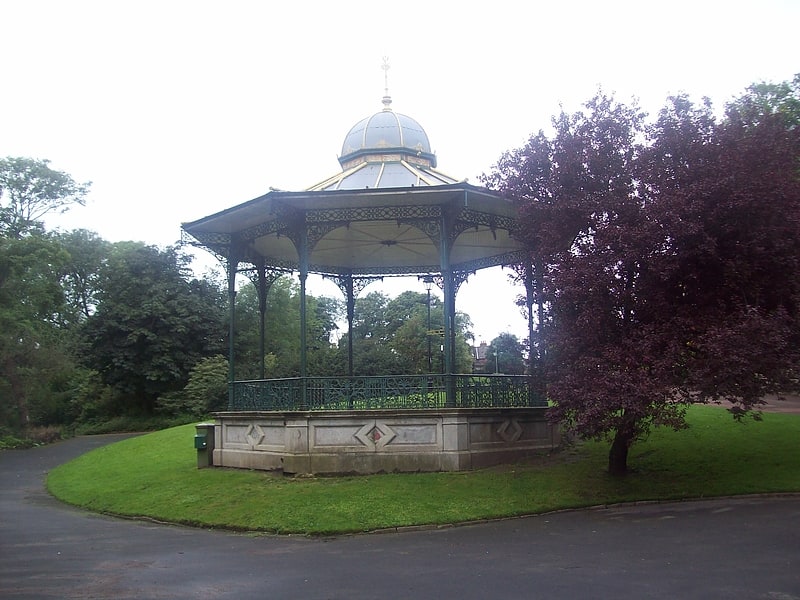
Park in Sunderland, England. Roker Park is a recreation park in the Roker area of Sunderland, Tyne and Wear, England.
The land on which the park stands was donated by Sir Hedworth Williamson, 8th Baronet and the Church Commissioners, and opened on 23 June 1880. The park is roughly an upside down reversed 'L' shape. It is bounded by Park Parade to the south, Roker Park Terrace to the east, Roker Park Road to the west and Side Cliff Road to the north. The northern part of the park is the widest and fronts onto Roker beach via a ravine, which passes under a wooden footbridge. In the centre of the park is a large freeform boating lake which is used for remote-controlled model boating. In the northwest corner of the park is a model narrow gauge railtrack which was built in the 1970s. There are two bowling greens as well as tennis and multi-purpose sports courts.[10]
Address: Roker Park Road, Sunderland
Barnes Park
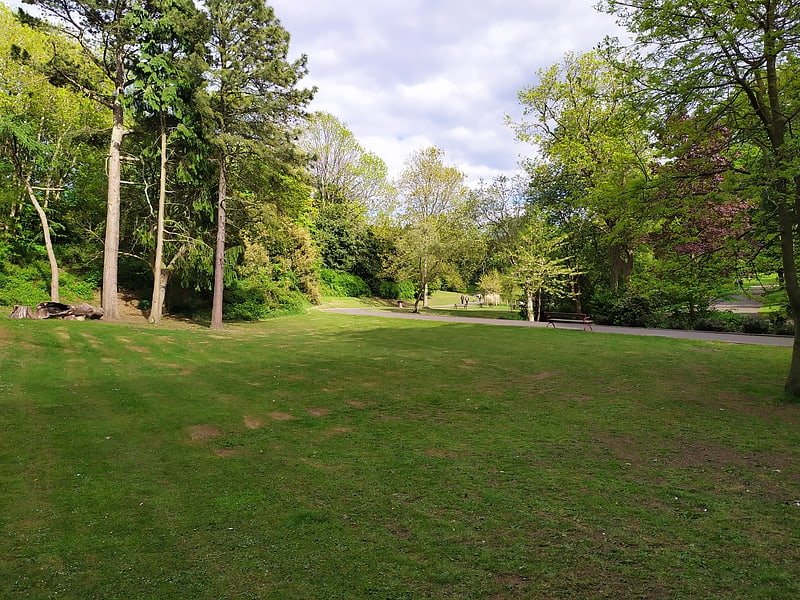
Park in Sunderland, England. Barnes Park is a historic public park in Sunderland, Tyne and Wear, England. Taken together with its post-war extensions, which run to the former county borough boundary, it is the largest park in the city.[11]
Address: Barnes Park Rd, SR4 7PY Sunderland
St Peter's Church
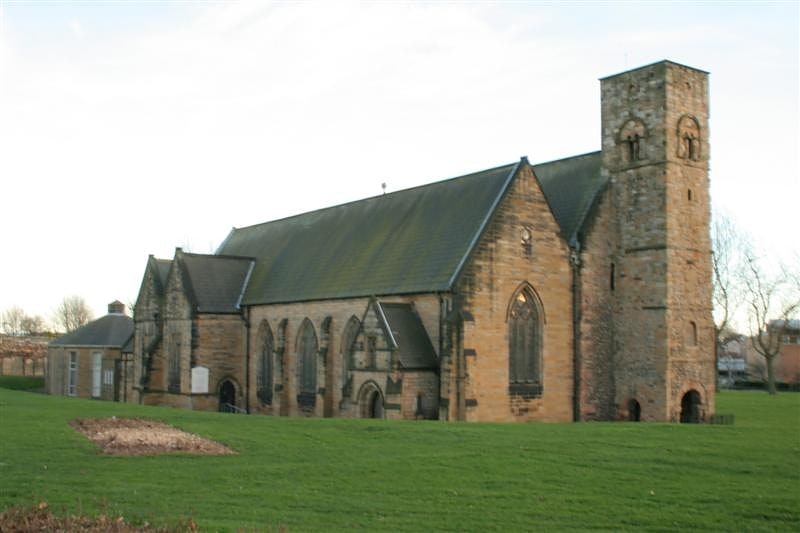
Parish church in Sunderland, England. St Peter's Church, Monkwearmouth is the parish church of Monkwearmouth in Sunderland, Tyne and Wear, England. It is one of three churches in the Parish of Monkwearmouth. The others are All Saints' Church, Monkwearmouth and St Andrew's Church, Roker.
St Peter's was founded in AD 674–5 as one of the two churches of the Benedictine double monastery of Monkwearmouth–Jarrow Abbey. The other church is St Paul's Church, Jarrow. St Peter's is a Grade I listed building and part of a scheduled monument.[12]
Address: St Peters' Way, SR6 0DY Sunderland
Victoria Viaduct

Bridge in Houghton-le-Spring, United Kingdom. Victoria Viaduct, originally known as the Victoria Bridge, is a stone arch rail viaduct spanning the River Wear about 1 mile south-east of Washington in North East England. It was built as part of the Durham Junction Railway under the supervision of Thomas Elliot Harrison.[13]
Sunderland Empire Theatre
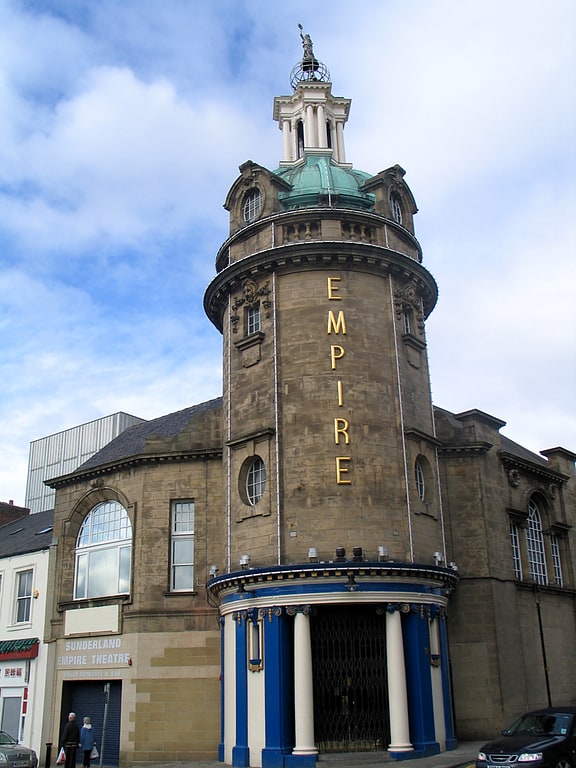
Theatre in Sunderland, England. The Sunderland Empire Theatre is a large theatre venue located in High Street West in Sunderland, North East England. The theatre, which opened in 1907, is owned by City of Sunderland Council and operated by Ambassador Theatre Group Ltd, on behalf of Sunderland Empire Theatre Trust.
The theatre is one of the largest venues in the North East, with 1,860 seats and the capacity to accommodate 2,200 when all standing positions are occupied. The auditorium is also one of the few remaining in the UK to have four tiers, namely the Orchestra Stalls, the Dress Circle, the Upper Circle and the Gallery. There are four private boxes on the Dress Circle level, as well as two proscenium boxes on the Upper Circle balcony.[14]
Address: Sunderland, High Street West
Wearmouth Bridge
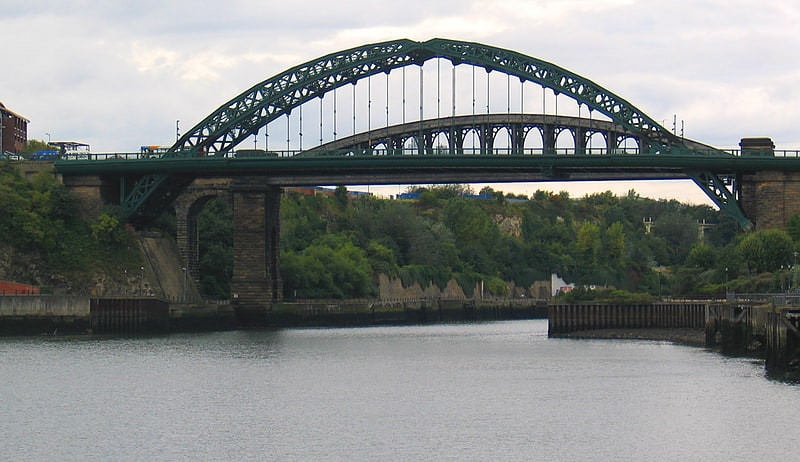
Through arch bridge in Sunderland, England. Wearmouth Bridge is a through arch bridge across the River Wear in Sunderland. It is the final bridge over the river before its mouth with the North Sea.[15]
St Michael and All Angels' Church
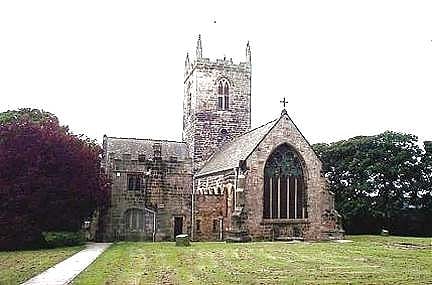
Church in Houghton-le-Spring, England. St Michael and All Angels' Church is the parish church of Houghton-le-Spring, Tyne and Wear, England. The church dates from the late 12th century and contains the tomb of Bernard Gilpin.[16]
Address: Church Street, Sunderland
Ryhope Engines Museum

Museum in Sunderland, England. The Ryhope Engines Museum is a visitor attraction in the Ryhope suburb of Sunderland, Tyne and Wear, England.
The Grade II* listed building is a popular landmark in Ryhope and is based at The Ryhope Pumping Station, operational for 100 years before closing in 1967. The building is more or less Jacobean in style with curving Dutch gables, and a tapering octagonal brick chimney. The historian of British industrial architecture Hubert Pragnell calls it a "cathedral of pistons and brass set within a fine shell of Victorian brickwork with no expense spared".
The volunteer-run museum contains two Victorian beam engines, which are kept in working order by members of the Ryhope Engines Trust. The site is owned by Northumbrian Water, successors to the Sunderland & South Shields Water Company which built the complex in the 1860s.
The engines are a near identical pair of double-acting compound rotative beam engines by the local North East firm R & W Hawthorn of Newcastle - 'possibly the finest pair of compound beam engines in Great Britain'. Each beam weighs 22 tons and each flywheel 18 tons. Both engines can be seen fully operational and in steam on various weekends and bank holidays each year.
The museum also contains three 1908 Lancashire boilers, a blacksmith's forge, a waterwheel, numerous steam engines and pumps, a replica plumber's shop, and many items associated with waterworks. In addition, visitors arriving in the engine house are now able to see to the bottom of the 250-foot well shaft by means of a viewing panel inserted in the floor.[17]
Address: Waterworks Rd, SR2 0ND Sunderland
Washington
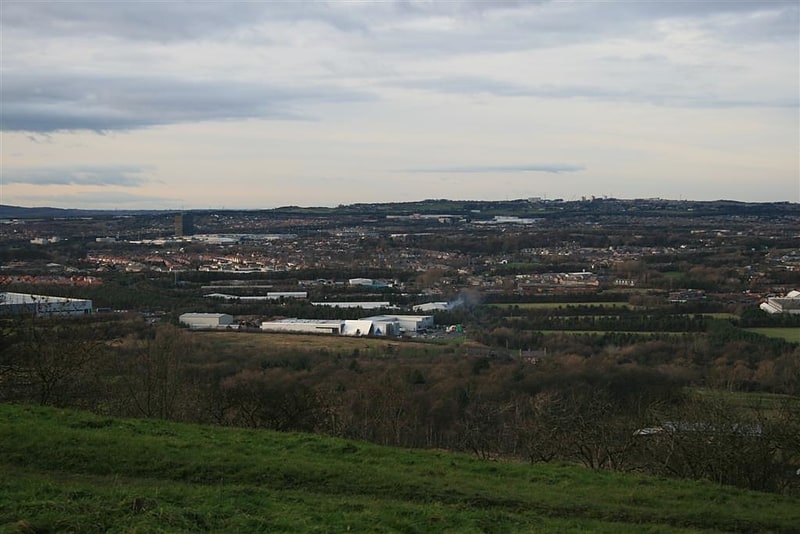
Town in England. Washington is a large town in the City of Sunderland local government district of Tyne and Wear, England, and historically part of County Durham. Washington is equidistant from the centres of Newcastle upon Tyne, Durham and Sunderland, with close ties to all three cities. It is the ancestral settlement of the Washington family, which George Washington descended from.
It is located between Chester-le-Street, Gateshead and Sunderland. Washington was designated a new town in 1964 and became part of the Borough of Sunderland in 1974, the borough became a city in 1992. It has expanded dramatically since its designation, by new villages created and reassignment of areas from Chester-le-Street, to house overspill from surrounding cities. At the 2011 census, Washington had a population of 67,085, compared to 53,388 in 2001.[18]
St Mary's Church
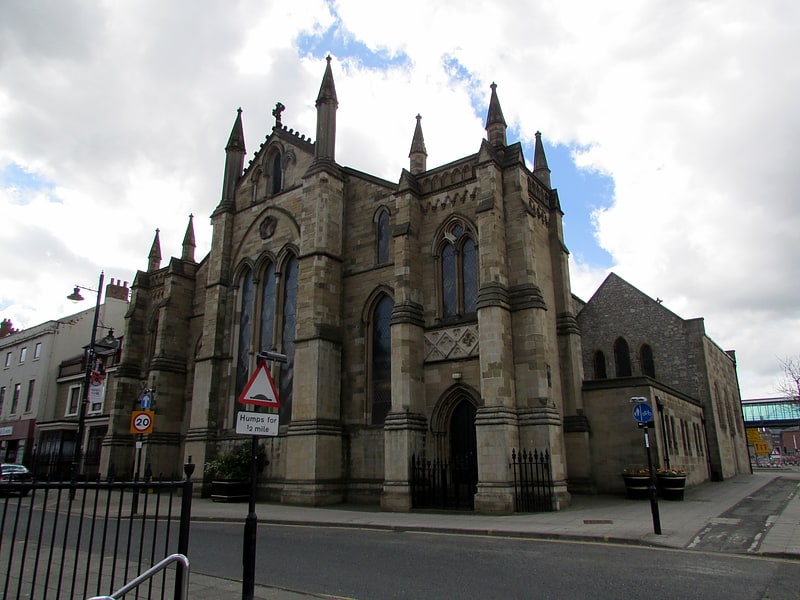
Parish church in Sunderland, England. St Mary's Church is a Roman Catholic parish church in the city centre of Sunderland, Tyne and Wear, situated on the corner of Bridge Street and St Mary's Way. It is a Grade II listed building, designed by Ignatius Bonomi. Built from 1830 to 1835, and is the earliest Gothic revival church surviving in Sunderland.[19]
Holy Trinity Church
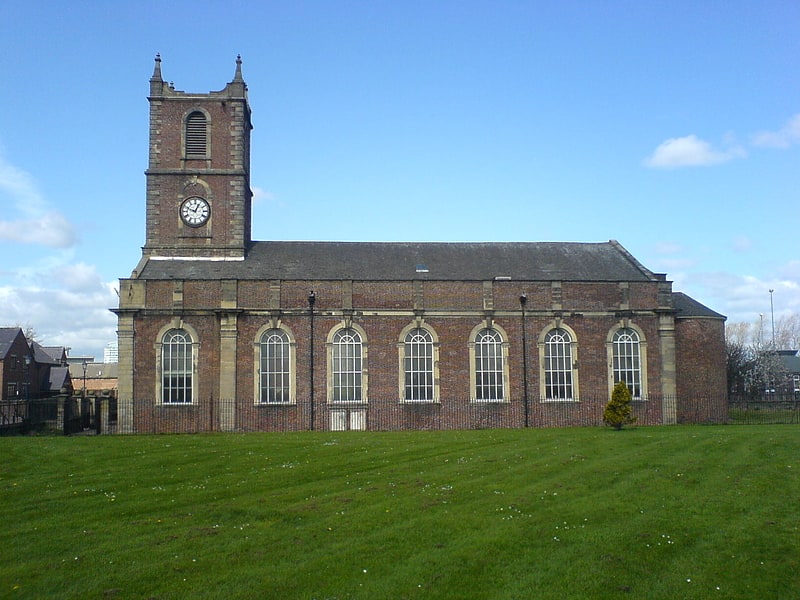
Church in Sunderland, England. Holy Trinity Church is an Anglican church building in Sunderland, Tyne and Wear formerly the area's parish church. It was opened in 1719 as the church for the newly created Parish of Sunderland, and served the local community until dwindling numbers forced its closure in 1988. It has since been in the ownership of the Churches Conservation Trust who have preserved the space and converted it into a community cultural hub.[20]
Address: Church St E, SR1 2BB Sunderland